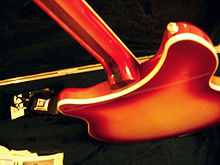Set-in neck

This set-in neck is most popular on acoustic guitars. Almost all major acoustic guitar manufacturers use set-in necks, with notable exceptions being Taylor Guitars and Collings Guitars. In the electric guitar market, Gibson traditionally produces almost all of its electric offerings as set-in neck models, as opposed to rival Fender, which traditionally builds its electric instruments (most notably, the Stratocaster, Telecaster and various Electric Basses) with bolt-on necks. There are other solutions used in very rare cases - Babicz Guitars make a neck that is mechanically joined and can be "wound" up or down to adjust action height.
Glues used
Wooden musical instrument construction relies on four widely used types of glues:
- Hide glue
- PVA (both "white glue" and "yellow glue")
- Epoxy and Cyanoacrylate are sometimes also used for neck joints, but generally such use is rare. Structure of these glues makes it difficult to disassemble joint later if repair or servicing is required.
Advantages
Typically cited advantages of set-in neck include:
- Warmer tone
- Usually better access to top frets in comparison to bolt-on necks utilizing a metal plate (as seen on Fender guitars)
Disadvantages
- Certain models are notorious for neck breakage - Gibson Les Paul (this is disputed, as mahogany, the most common neck material on Gibson guitars, is also somewhat more fragile)
- Harder and more expensive to mass manufacture than bolt-on necks, much harder to repair / service than a bolt-on neck - the glue must be steamed out/melted out with a hot knife; rather than just unscrewing it.
- Although commonly believed to have more sustain, this appears to have been the subject of only one formal but not peer-reviewed study [1] This study found the common wisdom to be mistaken, with somewhat greater sustain depending more on the quality of the joint.
- The player has no control over the neck-to-body angle; changing it requires disassembling the instrument and re-glueing the neck by an experienced luthier[citation needed]
References
- ↑ Mottola, R.M. “Sustain and Electric Guitar Neck Joint Type” American Lutherie #91, 2007, p. 52.
- Glue comparison chart on frets.com
| |||||